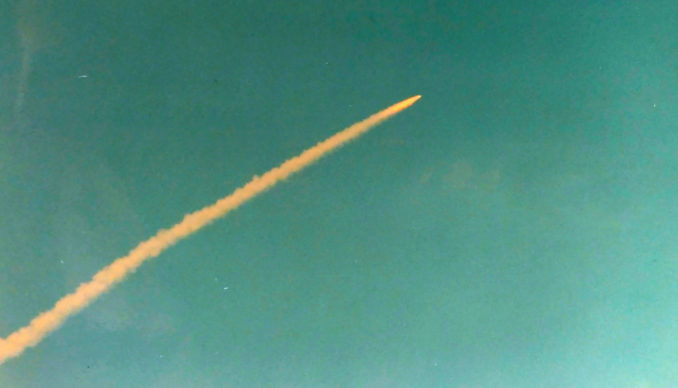
© Always Worth Saying, Going Postal 2020
During a presidential debate, a little old lady, her grey hair in a bun, asks, “Name the three most important Space Race countries”. Sleepy-creepy Jo Biden, from his basement and with the benefit of voice from an earpiece, replies, “New Zealand, Scotland and Iceland”. Don’t mock, he might have a point.
As every schoolboy knows, one would launch one’s satellite close to the equator in order to take advantage of the west to east rotation of the Earth around its axis and the west to east motion of the Earth around the Sun. Standing at the North Pole, one isn’t really moving at all, merely remaining still while rotating 360 degrees in 24 hours. Meanwhile, at the equator, you are travelling the circumference of the earth (roughly 24,000 miles) every day. Therefore, you are travelling at about 1000 miles per hour.
The Qualitative Reasoning Group of Northwest University sum it up nicely,
“If a ship is launched from the equator it goes up into space, and it is also moving around the Earth at the same speed it was moving before launching. This is because of inertia. This speed will help the spacecraft keep up a good enough speed to stay in orbit.”
Cape Canaveral, the American launch site, is almost as far south as you can be in the United States but is still 28 degrees north. At this latitude, a friend tells me, the rotation of the Earth has reduced to 914 mph. The French, for once, are closer to the mark. Their launch area is at Kourou, in French Guyana, only 4 degrees from the equator.
Of course, if we wanted a different orbit, perhaps north/south, we’d benefit from being further away from the Equator, where we wouldn’t have to overcome an initial west to east movement sending us in the wrong direction. But why would you want to orbit the poles? There are lots of different types of orbits, they all have their uses.
In the 1968 Cold War thriller, Ice Station Zebra (spoiler alert) a Soviet spy satellite is in a Molniya orbit. Bigly inclined from the Equator, it passes over both the USA (taking spy photographs) and the USSR, to where it will dispatch the film in a re-entry vehicle. As the earth rotates, and the satellite crosses different longitudes, it passes and photographs different parts of the USA and, as the camera malfunctions, accidentally photographs different parts of the USSR too. A bad week in the officeski ends with it dropping the film onto Greenland by mistake.
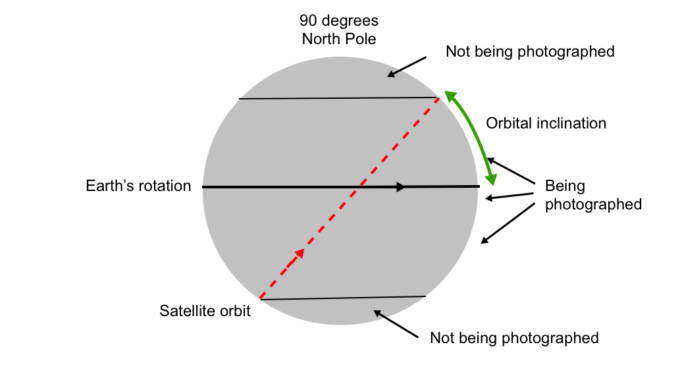
© Always Worth Saying, Going Postal 2020
Of course, if a satellite orbits pole to pole (a 90 degrees orbital inclination) then the entire world will pass beneath it, allowing, across a period of time, everywhere to be photographed. In order to get nice pictures, we want to be close to the Earth’s surface. This is called a ‘Low Earth Orbit’ or LEO.
When launching a satellite, we are not blasting our rocket upwards into outer space, we are lobbing it high enough and fast enough for it to freefall into a stable orbit, as the force of gravity pulling it towards the earth is balanced by the force pushing it forward.
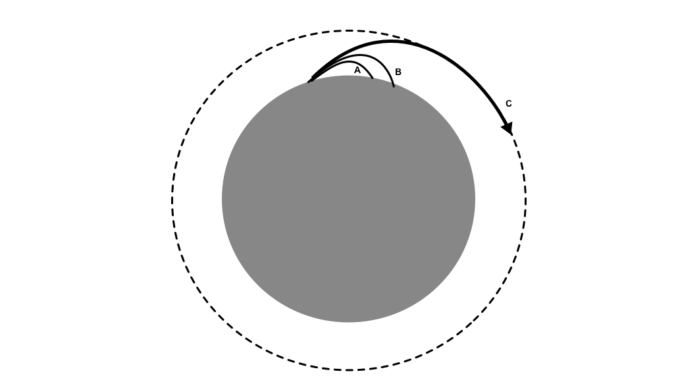
© Always Worth Saying, Going Postal 2020
As you get further away from the Earth, the Earth’s gravitational effect lessens. Therefore, the forward force exerted upon our satellite, required to balance the downwards pull of the Earth, must also be less meaning that higher orbits are slower than lower orbits.
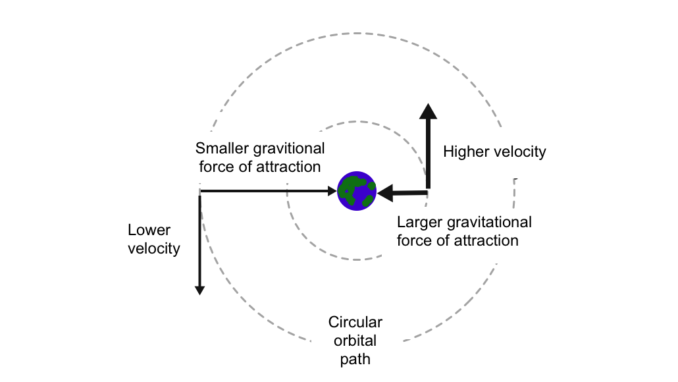
© Always Worth Saying, Going Postal 2020
Hence, to get nice photos, our spy satellite will be travelling quickly in a low Earth orbit. A disadvantage of an LEO is that the satellite is over a particular place for a short period of time and the field of view (the distance to its visible horizon), is relatively small.
Back in the day, a friend told me that you could see what newspaper Brezhnev had tucked under his arm and what brand of cigarette packet he was opening, but you had to phone ahead and tell him when to have his Red Square fag break. It would also be a big help if he was pointing in the right direction.
Those very clever people at calctool tell us that an orbit at 350km (217 miles) above the earth will take 90 minutes at a speed of 7.7 km/s (17,224 mph). As every Puffin knows, the percentage of a sphere visible is 50% / (1 + (Radius of sphere/distance from it)). Putting some numbers in, the radius of the earth is 6300km, we shall use that low Earth orbit of 350km:
50% / (1 + (6300/350)) = 2.6%
From our one satellite, 2.6% percent of the world is visible at any one time. If we want to observe more than 2.6% simultaneously, then we need more satellites.
During that 90 minute orbit, parts the world beneath us will have moved a greater distance than the field of vision that we could observe on our previous pass. If we want to photograph the whole of the world in a day, we need more satellites.
It’s even more complicated than that. The world isn’t a sphere, it is an ovoid, as the rotation of the earth pushes out the Equatorial latitudes. No it isn’t, it’s a geoid, the surface being covered in geological features rather than being smooth. No it isn’t, it’s an anthropogeoid, a word I’ve just made up to describe the combined effect upon a surface of man-made and natural structures, which will get in the way of our photography.
We’re going to need more satellites.
What other uses are there for north/south orbits? If we know at what time Breshniev habitually takes his fag break, we can incline an orbit from the pole which allows for a pass of the same point, every day, at the same time. This is called a “sun-synchronous” orbit. Such an orbit can also observe the ground passing beneath it in constant daylight. With this in mind, we need more satellites.
Two advantages of an LEO are worth pointing out. Firstly, it is cheaper to launch into a low orbit than a high one, less energy is required meaning less fuel and a smaller rocket. There is a virtuous cycle that rocket engineers can enter. The rocket consists of the fuel, payload and rocket body. The fuel required is a multiple of the efficiency of the engine combined with the mass of the rocket, mass of the payload and the mass of the fuel. If you make the payload smaller, there is less fuel, which means a smaller rocket, which means less fuel, which means etc etc. Likewise, if you make the engine more efficient or make the rocket body lighter.
Another advantage of an LEO is low communication latency. ‘Latency’ means the time taken for data to get to its destination and then back again. In the days of Ice Station Zebra spy satellite latency was vast. You had to go to Greenland, find the film, (spoiler alert) wrestle with Herbert Lom, get the capsule to submarine commander Rock Hudson (“We’re all on first-name terms here and my first name is ‘sir’.”), sail to Faslane and then take the film to the chemists.
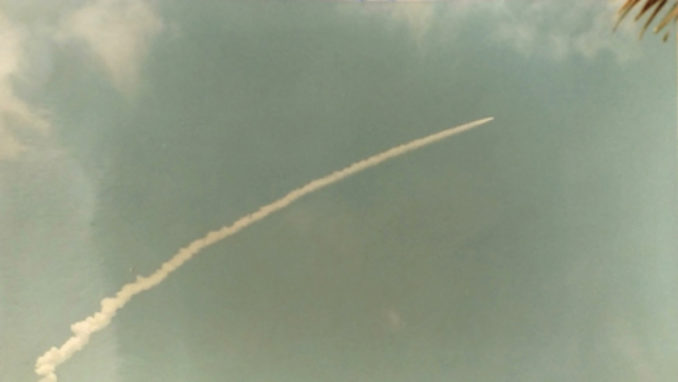
© Always Worth Saying, Going Postal 2020
In this modern-day of electronic telecommunication, latency is much lower but we still want as little ‘lag’ as possible. In conclusion, what do we need if we’re going to spy on the whole world simultaneously? We need a large number of small satellites, deployed by small, light rockets with very efficient engines, launched from near the poles. Says who? Says Uncle Sam, and he’s in a hurry. On June 18th 2019, outgoing vice chairman of the Chief of Staff, the second highest-ranking US military officer, General Paul Selva told SpaceNews that,
“Military forces in the field need “ubiquitous communications” and other capabilities that could be provided by large networks of satellites,”
These large networks of satellites are known as ‘constellations’. SpaceNews went on to report Selva as complaining that,
“during the Cold War built hundreds of low-altitude remote sensing satellites. “But we abandoned our capacity to do it because we developed a new more elegant technology that was huge expensive satellites that could do multiple tasks,” he said. These large satellites were put in high orbits to perform tasks that are “exorbitantly more complex than what we used to do from LEO, which was take pictures,” he said. “How many aerospace engineering are still around that still remember when we built satellites en masse? The answer is very few.”
Step forward counties like Iceland, Scotland and New Zealand and take a bow private sector companies like Rocket Lab, Skyrora and Orbex. Skyrora are based in Edinburgh, with a head office in Princess Street and workshops on a nearby industrial estate. They have already conducted test launches from Iceland and the Kildermorie Estate in Ross-shire.
Senior people include Volodymyr Levykin, a Clackmannanshire Levykin?, Victor Ivananko, a fourth cousin of the late Queen Mother (maybe not) and Aleksey Grebenyuk, a direct descendant of Rob Roy, or not. If you can detect a whiff of a scent of a hint of the Ukraine about the place, you’d be correct.
Skyrora are proud to work as partners with an innovative co-working centre, located in Dnipro, home of the Yuzhnoye Design Office, Yuzhmash Machine Building Plant and Khartron Missile Control Systems. These are the nice people who, during the cold war, brought us such jollies as the hammer and sickle embossed SS-18 Satan intercontinental ballistic missile.
Skyrora, and their competitors, boast game-changing technological advances (such as 3D printed engines) and new materials (for instance, carbon composites) which will revolutionise the low-cost LEO launch industry. We shall hire them to launch all of our satellite constellations and we shall do it yesterday.
Incidentally, who are ‘we’? ‘We’ are the National Reconnaissance Office, the motto of the NROL 39 launch was, “Nothing is Beyond Our Reach”. The logo? A giant octopus overwhelming the entire world. Puffins will learn more about the NRO and its activities in a companion article.
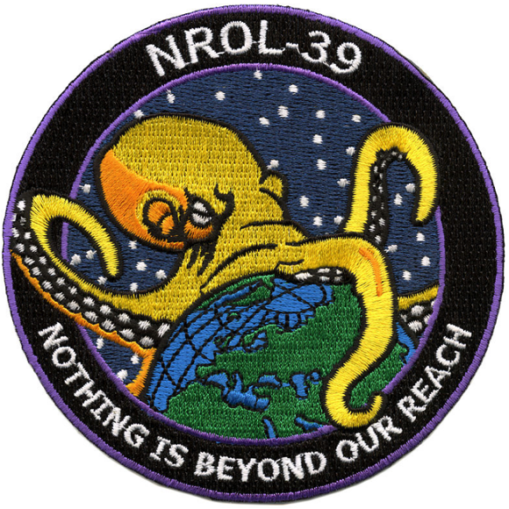
NROL 39, National Reconnaissance Office – Public Domain
Acknowledgements
Christopher Beam, MIT Technology Review
Nasa
Skyrora
SPACENEWS
Wiki
The Goodnight Vienna Audio file
Audio Player



